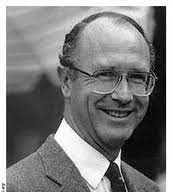David P. Gardner
David Pierpont Gardner was a university administrator and served as the 10th president of the University of Utah. According to a statement from the U., Gardner is credited with elevating the academic excellence and prominence of the university and strengthening its status as a major research institution. He was a widely recognized thought leader and expert on education. He advocated for improving American public schools and making undergraduate education a national priority.[1]
More recently, he was the president of the University of California. He was also Professor of Higher Education Emeritus at both institutions.
Gardner was born on March 24, 1933, in Berkeley, California. He received his bachelor’s degree in political science, history, and geography from Brigham Young University. He held a master’s degree in political science and a PhD in higher education from the University of California, Berkeley.
His first appointment was as Assistant to the Chancellor at University of California, Santa Barbara. In 1967 he was also appointed Assistant Chancellor and Professor of Higher Education. In 1971, he accepted the position as the Vice President for Public Service Programs and University Dean of University Extension for UC Berkeley. In 1972, he became the Vice President for Extended Academic and Public Service Programs in the Office of the President in the UC system.
In 1973, he became the president of the University of Utah where he stayed until 1983. Gardner Hall on President’s Circle at the University of Utah was renamed in his honor. The concert hall within the same building was named in honor of his wife, Libby Gardner, after she passed away in 1991.
He returned to the University of California system as president in 1983. His wife Libby was named as Associate to the President and the two worked together closely until her death from heart failure in 1991. He then resigned effective 1992, stating that he could not continue without her.[2]
Gardner is credited with strengthening the University of California system’s financial base. He successfully campaigned for a permanent 32 percent increase in state funding, allowing the university to raise faculty salaries and undertake several new initiatives. He helped secure public and private funding for a $3.7-billion building program. During his tenure, the University of California increased admissions requirements and improved academic standards. Enrollment rose by 25,500 to 166,500. In response to a projected 60,000 additional students by 2005, Gardner proposed a tenth campus. UC Merced was completed after his departure.[3]
From 1993 to 1999, he was president of the William and Flora Hewlett Foundation. In 2001, he became a professor of educational leadership and policy in the Graduate School of Education at the University of Utah. He served as Chairman of the Board of the J. Paul Getty Trust from 2000 to 2004.
He and his wife Libby are the parents of four daughters. In 1995, he married Sheila S. Rogers.
He also chaired the National Commission on Excellence in Education, whose members wrote the 1985 well-known educational document, "A Nation at Risk." The report helped bring about a reform movement in education such as the country had not seen for decades. In 1974, a Time magazine article named Gardner one of the 200 men and women “destined to provide the United States with a new generation of leadership.”
Gardner gained national recognition as an expert on higher education, publishing dozens of books, articles, and reports throughout his career. He wrote a memoir, “Earning My Degree: Memoirs of an American University President,” in 2005.
Gardner was a member of The Church of Jesus Christ of Latter-day Saints.
Gardner died on January 2, 2024.
